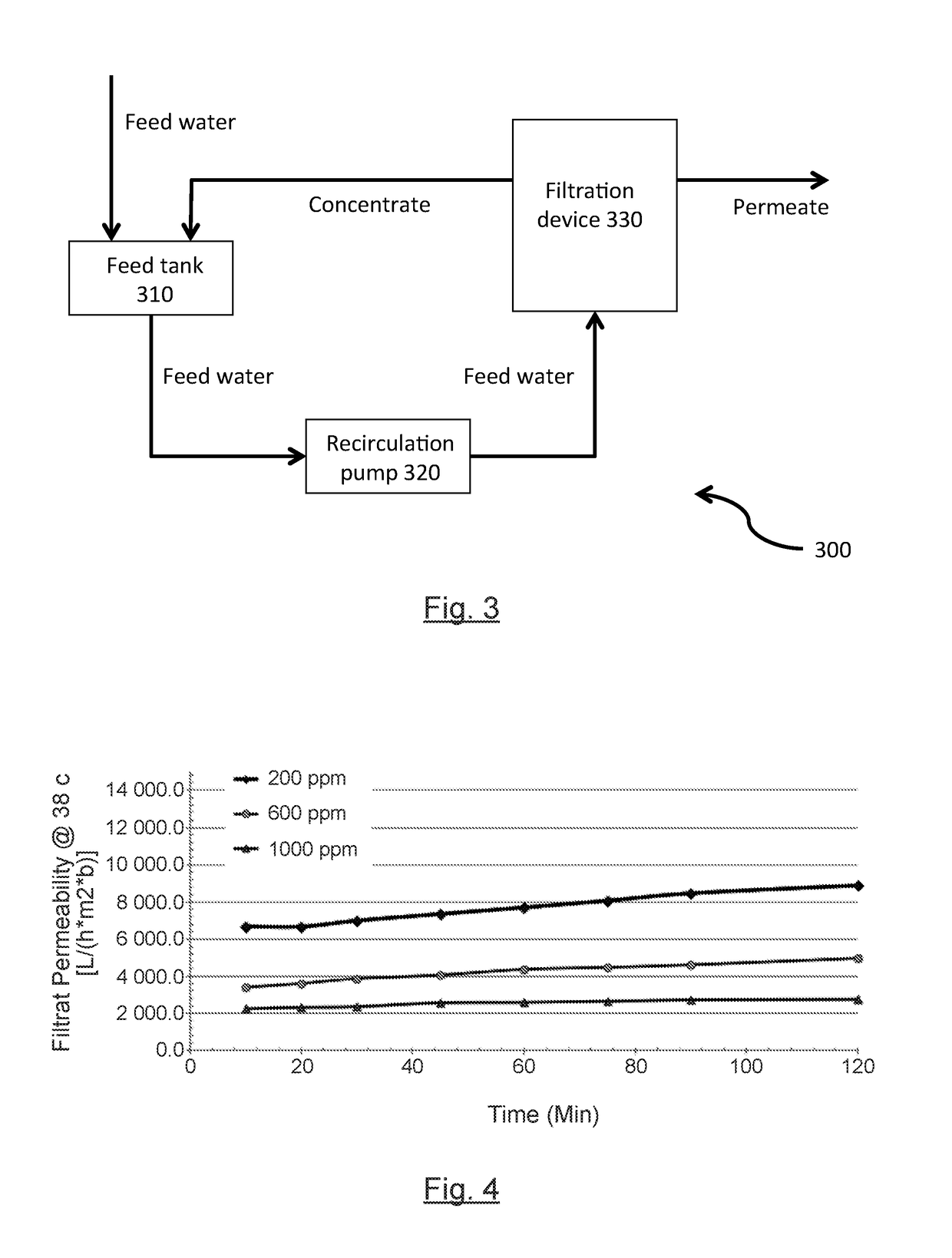Treatment of produced water, particularly obtained from a chemically enhanced oil recovery process using viscosity-increasing polymers
a technology of viscosity-increasing polymers and produced water, which is applied in the nature of treatment water, membranes, borehole/well accessories, etc., can solve the problems of difficult treatment of produced water, increased extraction of ooip by 15% to 30%, and limited water supply, so as to reduce the amount of new, and limit the effect of membrane fouling
- Summary
- Abstract
- Description
- Claims
- Application Information
AI Technical Summary
Benefits of technology
Problems solved by technology
Method used
Image
Examples
example 1
oncentration Comparison
[0154]It has been tested the impact of the concentration of the polymers into the aqueous solution on their permeability through different ceramic membranes.
[0155]The following polymers have been tested:[0156]poly(acrylamide-co-sodium acrylate), with a molecular weight of 7 MDa (herein as “7 MDa polymer”),[0157]poly(acrylamide-co-sodium acrylate), with a molecular weight of 15 MDa (herein as “15 MDa polymer”).
[0158]Four different concentrations of polymer have been tested, namely 200 ppm, 600 ppm, 600 ppm degraded (except for the test of the 7 MDa polymer on the uncoated SiC monolith membrane), and 1000 ppm. When applicable, the polymer is degraded by subjecting it to a high pressure, then dropping the pressure.
[0159]The following ceramic membranes have been tested:[0160]uncoated SiC monolith ceramic membrane, having a membrane cut-off of from about 5 to about 10 μm;[0161]standard TiO2 microfiltration ceramic membrane, having a membrane cut-off of about 0.1 μm...
example 2
tion on Ceramic Membrane (Close Loop)
[0171]It has been tested the efficacy of the permeability of the ceramic membrane, depending on the non-continuous addition of oil.
[0172]A schematic representation of the pilot unit is shown on FIG. 2. In the pilot unit 200 shown in FIG. 2, the feed water is directed from the feed tank 210, via a recirculation pump 220, to the filtration device 230, wherein it is subjected to filtration. From this filtration step, it is obtained a permeate stream and a reject stream, which are both fed into the feed tank 210. A transmembrane pressure is applied to the filtration device (not shown).
[0173]The following polymer has been tested:[0174]poly(acrylamide-co-sodium acrylate), with a molecular weight of 7 MDa (herein as “7 MDa polymer”) at a concentration of 600 ppm
[0175]The following ceramic membranes have been tested:[0176]uncoated SiC monolith ceramic membrane, having a membrane cut-off of from about 5 to about 10 μm
[0177]The filtrations have been carrie...
example 3
tion on Ceramic Membrane (Continuous Feed)
[0190]It has been tested the efficacy of the permeability of the ceramic membrane, through a continuous extraction of the permeate and the concentrate.
[0191]A schematic representation of the pilot unit is shown on FIG. 3. In the pilot unit 300 shown in FIG. 3, the feed water is directed to the feed tank 310. The feed water is then continuously directed from the feed tank 310, via a recirculation pump 320, to the filtration device 330, wherein it is subjected to filtration. From this filtration step, it is obtained a permeate stream and a reject stream. The reject stream is directed back from the filtration device to the feed tank 310. A transmembrane pressure is applied to the filtration device (not shown).
[0192]The following compounds have been tested:[0193]7 MDa polymer at a concentration of 600 ppm;[0194]Oil at a concentration of 1000 ppm;[0195]Total Suspended Solids at a concentration of 50 ppm and with a particle size of about 100 μm to...
PUM
| Property | Measurement | Unit |
|---|---|---|
| pressure | aaaaa | aaaaa |
| temperature | aaaaa | aaaaa |
| droplet size | aaaaa | aaaaa |
Abstract
Description
Claims
Application Information
 Login to View More
Login to View More - R&D
- Intellectual Property
- Life Sciences
- Materials
- Tech Scout
- Unparalleled Data Quality
- Higher Quality Content
- 60% Fewer Hallucinations
Browse by: Latest US Patents, China's latest patents, Technical Efficacy Thesaurus, Application Domain, Technology Topic, Popular Technical Reports.
© 2025 PatSnap. All rights reserved.Legal|Privacy policy|Modern Slavery Act Transparency Statement|Sitemap|About US| Contact US: help@patsnap.com



